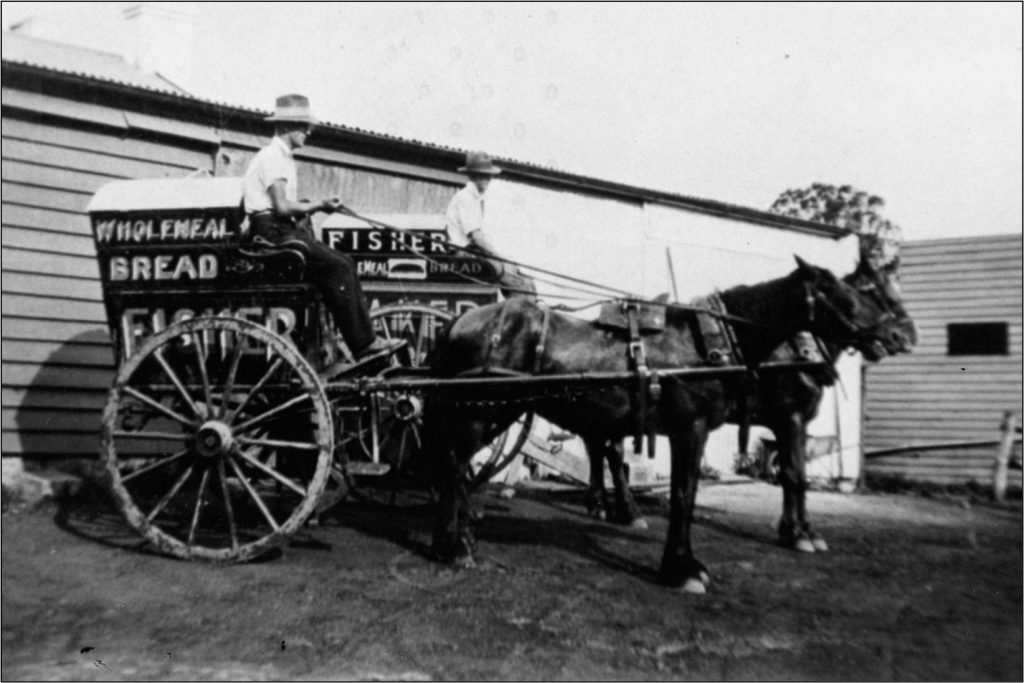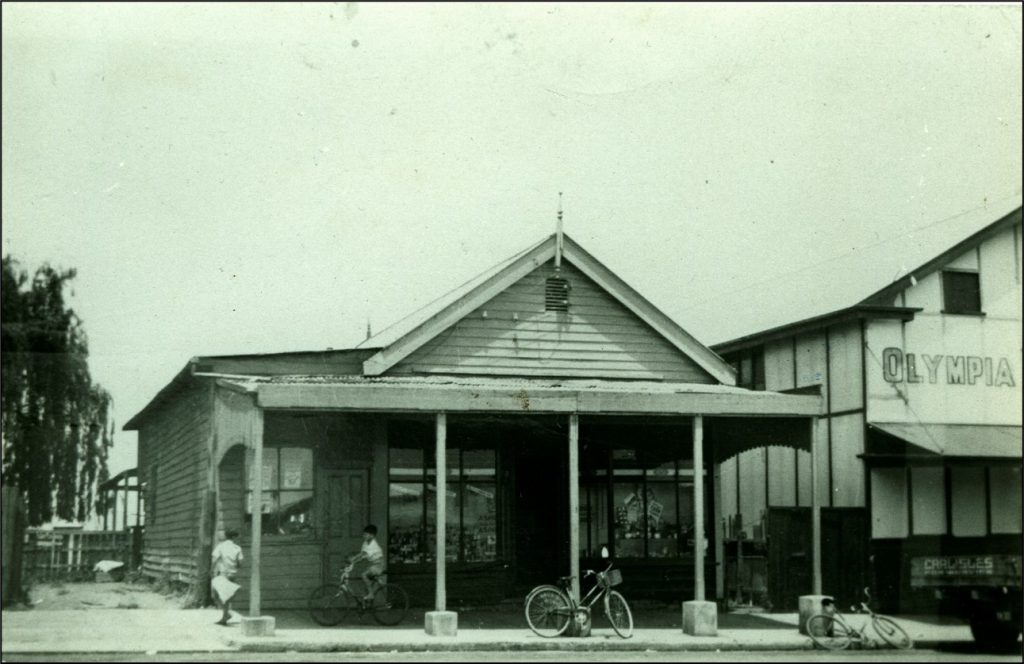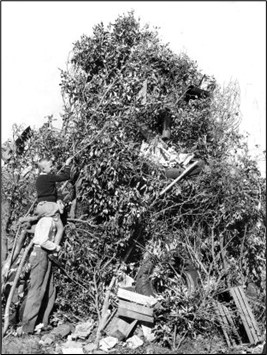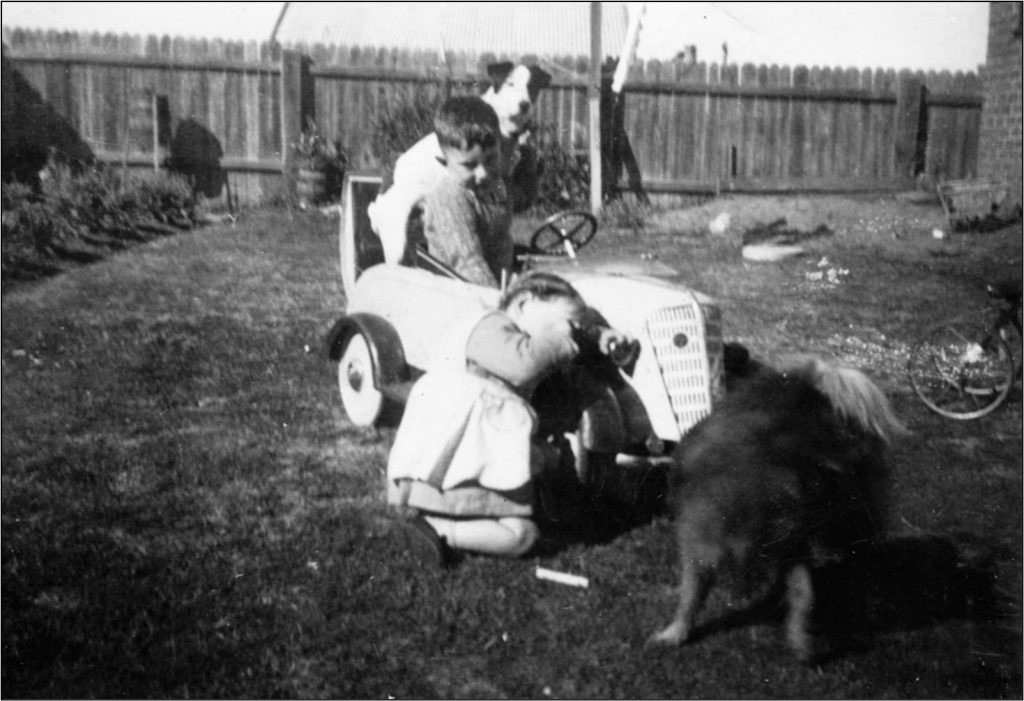By Judith Lewis OAM
As we drive around Riverstone, Vineyard and Schofields at present we can’t help but ask, “Is this progress?” At 80 years of age let me tell you about the Riverstone I grew up in. I know which one I prefer.
Our home, double brick, was on two blocks of land. One block contained the house, outside toilet, bird aviary, clothes line, which stretched across the block, enough space on the driveway side to play a form of modified cricket and, during the war years, an air raid shelter. The other block had a small orchard of about a dozen fruit trees, apricot, green apple, mandarin, mulberry, nectarine, orange, 2 different types of peach – yellow and white fruit and grape vines, pigeon pens, work shed and a “chook run”. The house had verandahs front and back so there was always somewhere to play. When my future husband and I we were having plans drawn up for our new home my father insisted in our climate we needed verandahs and we never regretted taking his advice. Our kids, and half the neighbourhood’s kids always had somewhere to play too!
Where do today’s kids play?
Family life was certainly different. Most mothers stayed home to raise their children. The War changed that. With the shortage of manpower women were needed in the factories and many were employed at the Meatworks. It must have been tough for those with families whose mothers chose to work because there weren’t many labour saving devices around the homes. In most homes Monday was washing day. A fire had to be lit under the copper, possibly the wood may have had to be cut, Sheets, pillowcases, towels, tea towels etc. were boiled in the copper, other items (delicates) were washed by hand in water from the copper, all were rinsed in “blue” water courtesy of Reckitts Blue Bags and all items were wrung dry manually, mostly using a hand wringer attached to the laundry tubs, Once the sheets etc. were out of the copper it was in use again for heavier work clothes etc…The wash took hours to complete and hang out. Then much of it had to be prepared for ironing with tea towels, aprons, tablecloths, doylies etc. being sprayed with cold water and wrapped in a towel before ironing. Most mothers left ironing till Tuesday. My mother was lucky, she had a washing and ironing lady. (She had Pagets’ Disease which limited her movement.)
Today’s fabrics require little ironing and washers and dryers are standard equipment in all homes.
Where the 1940s mother had it all over today’s mum, was in the shopping department. Most goods were home delivered FOR FREE. It began with the daily paper, thrown over the front fence early each morning by Eric Conway from Conway’s Newsagency. Eric was often accompanied by a local lad who volunteered his services (also free of charge – it was considered a real privilege to ride with Eric). Next came the milkman, Jim Martin, who filled your left-out milk can. Before lunch came Bill Schofield from Fisher’s Bakery, with his horse and bread cart School had a full hour for lunch and most kids went home for lunch (nothing nicer than freshly baked bread and golden syrup).
Why does it not taste so good today?

Groceries were another home delivery. You took, or sent, your order down to the shop, the shopkeeper checked it out with you, then would deliver the order that afternoon or the next day. Many of the goods such as flour, sugar, biscuits etc. were in store in bulk and needed to be measured out to suit the customers’ wants. There were three grocery stores in Riverstone, Carlisle’s (the shop still stands but has been for sale and empty. It is alongside BWS) It was run by Roy Cooke and family, Rosenthal’s was a very large general store where you could buy practically everything.

It was run by Lyle Rosenthal whose family lived above the store which was situated on the corner of Garfield Road and Railway Terrace. Knights, originally owned by Charlie Knight and family, later to be owned by Wally Wood and family was where A&P Motors is now housed. Dick Stacey whose shop was in Garfield Road brought his laden truck around the town to provide fruit and vegetables as did (on a smaller scale) Billy Blair, also from Garfield Road. My mother also had a travelling salesman, from Parramatta, Mr. Burns, who called on a Saturday. He had a lending library which my mother used. He also had a black market supply on items such as butter which needed ration cards for purchase.
Don’t ask me how it worked I only know the butter tasted heaps better than the margarine which was the alternative and nothing like today’s margarine.
School days were happy ones. I don’t remember ever doing any homework. The cane was used a fair bit but I don’t recall ever seeing the actual caning. After school we nearly always played outside until dark or teatime and often played outside again after tea until it was finally too dark. The most popular outdoor game was “Countries”. Each person chose to be a country. A ball was thrown high into the air with the caller calling out the name of the country. Everyone scattered, unless it was your country that had been called. If that was the case you had to get the ball and call “Freeze”. You were then allowed to take three steps before trying to hit your target of the closest “frozen” person. Sometimes we came in onto the verandah for games more suitable, such as “cigarette cards”. Cigarettes came in colourful packets in those days. The empty packet was folded flat and flicked against a wall. The owner of the card that had landed closest to the wall threw all the cards at the wall and called “Heads” or “Tails”. He got to keep all the cards that fell to his call. It was a good game to play but girls never played it (unless your brothers allowed you).
Because of the ground space we had, and the verandahs, our home was where the neighbourhood kids gathered. Unfortunately there were hardly ever any girls as they were all too “grown up” for me, so I tagged along with the boys. One day we were playing Cowboys and Indians. I was an Indian who was captured early in the game and spent most of the rest of it tied up (that got rid of one pesky girl). I also traipsed through the bush to collect bushes and branches for the Empire Day Bonfire each year and happily joined the boys when we rode our pushbikes out to Andy’s Dam near the Windsor Road for a swim in the summer. Because there were few cars in Riverstone the dirt road of George Street was often used for hopscotch or “Fly”, a popular game where you took steps between the sticks (about 6 of them). The spaces between the sticks got wider and wider and towards the end of the game you literally had to “fly” to make the necessary steps between the sticks.
Bonfire Night was 24th May, Empire Day and Queen Victoria’s birthday. May holidays had just concluded. Most of those holidays had been spent collecting fuel for the Bonfire. This involved daily treks into the bush looking for suitable bushes, especially the centre pole which needed to be strong enough to hold the weight of the other branches. Our route took us up what is now Dingle Street to Pearce’s cottage (still standing), where we had to squeeze through where two fences didn’t quite meet (hence the squeeze), along Hamilton Street to Brisbane Street then into the bush, sometimes as far as the Windsor Road. The boys toted their fathers’ axes. We were considered to have one of the best bonfires so had to maintain the standard.
Today fireworks are almost a no no!

Our Weekends rarely changed. Saturday was “Flicks” afternoon at the Olympia Picture Theatre, where you saw two feature movies, a newsreel and a serial. Sunday was Sunday School, in the afternoon. Other Special days were the Sunday School Picnic in October and Prize Giving in December. Also “special” were the annual trips to the city for a picnic lunch, with our city cousins, in the Royal Botanic Gardens. As were the visits those cousins made out to see us, all done by train. They especially enjoyed being able to ride pushbikes on the roads. There was usually a pantomime at Christmas time at the Tivoli or one of the other theatres. Churches usually had annual bazaars and the CWA often organized a Fancy Dress Parade. Most of these were held either at the church itself or at the Masonic Hall, now the Museum. All of the above was happening in neighbourhoods around Riverstone (and probably around Australia).
In 1947 a new teacher at the school, Deputy Principal Jim Russell, encouraged sports to be played before school and at lunchtime. Basketball (Netball), Cricket, Softball and Vigoro became very popular. After school there were plenty of open areas where boys could play cricket. In mid 1940’s I recall a game of cricket played in paddocks in Mill Street between a side from Riverstone and a side from Rosehill. Our neighbour, Matt Johnston, lived in Mill Street. His aunt and uncle had moved to Rosehill and the game was arranged by the two Mrs. Johnstons. Matt, his cousin, John Warters, my brother Bill Shepherd, were joined by Ron and Norman Shields, Clarrie and Ron Neal, Charlie Wheeler, Jack Douglas and Peter Bradley and one other to make up the Riverstone team. I was invited by Mrs. Johnston to help make the sandwiches for lunch. A return match was later played at Rosehill in 1946.
Pets were always part of our lives. We always had a dog. The first pet dog I remember (1942) was “Teddy’’, the Pomeranian. He had been my maiden aunt’s dog but she had moved to a flat and dogs weren’t allowed. Teddy had little time for children. We bought a “child friendly” fox terrier “Popeye”. He was great, very protective of us kids. When my mother took us to the shops Popeye stayed with the pram and literally guarded it.

Over the years there were many dogs but my all-time favourite was the last, “Bandit”. He was our youngest son’s cross bull-terrier, banished to live with us after he had chased three sheep into Paul’s father-in-law’s dam, where they had drowned. Each afternoon Bandit would sit in the middle of Park Street from about 3:00pm waiting for me to come home from school. As soon as I turned the Piccadilly Street corner he would charge to greet me!
Older brother, Bill, and a mate, Reg Anderson, were keen on bird catching so my father built Bill a very large aviary in our yard. It was soon well occupied. Guinea pigs were popular at one stage. Guinea pig racing was even more popular. There were sometimes some baby rabbits after my father had caught, and we had eaten, the mother. My eldest granddaughter, now a Doctor of Veterinary Science, commented recently, “I’m so glad my parents taught me a love of animals”.
Today’s children miss out on all of the above and they call it ”progress”?
Some years ago a public meeting was called to discuss the location of the proposed new railway crossing. An overpass at Loftus Street was, by far, the most popular option with the meeting and in public votes collected by Michael Murray. What did we get? A crossing most drivers go out of their way to avoid. At the meeting a newcomer to the district spoke, telling of his life before moving to Riverstone. He had lived in a unit and barely knew any of the other residents of that block, let alone those of his suburb. Then he discovered Riverstone where he knew and socialised with his neighbours, In his own words he described Riverstone as “The best little country town in Sydney”.
Who will be the only ones to ultimately gain from this “Progress”? The developers!
